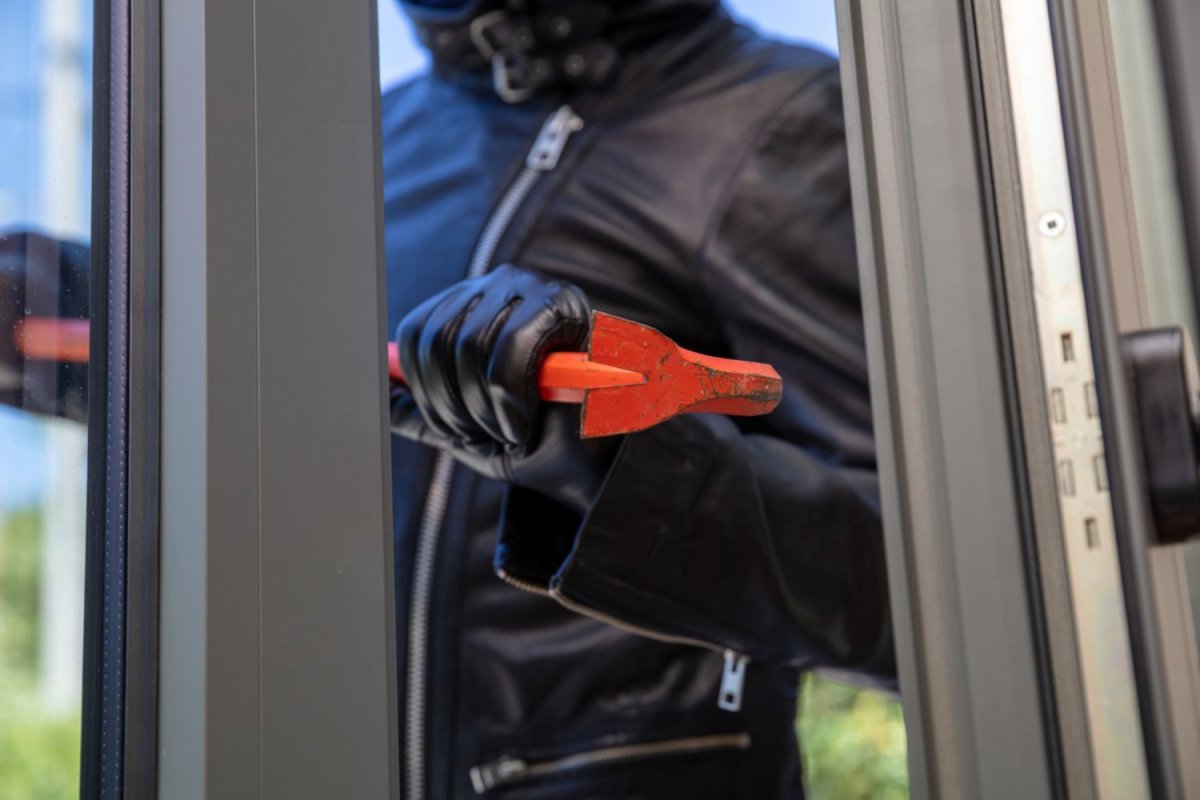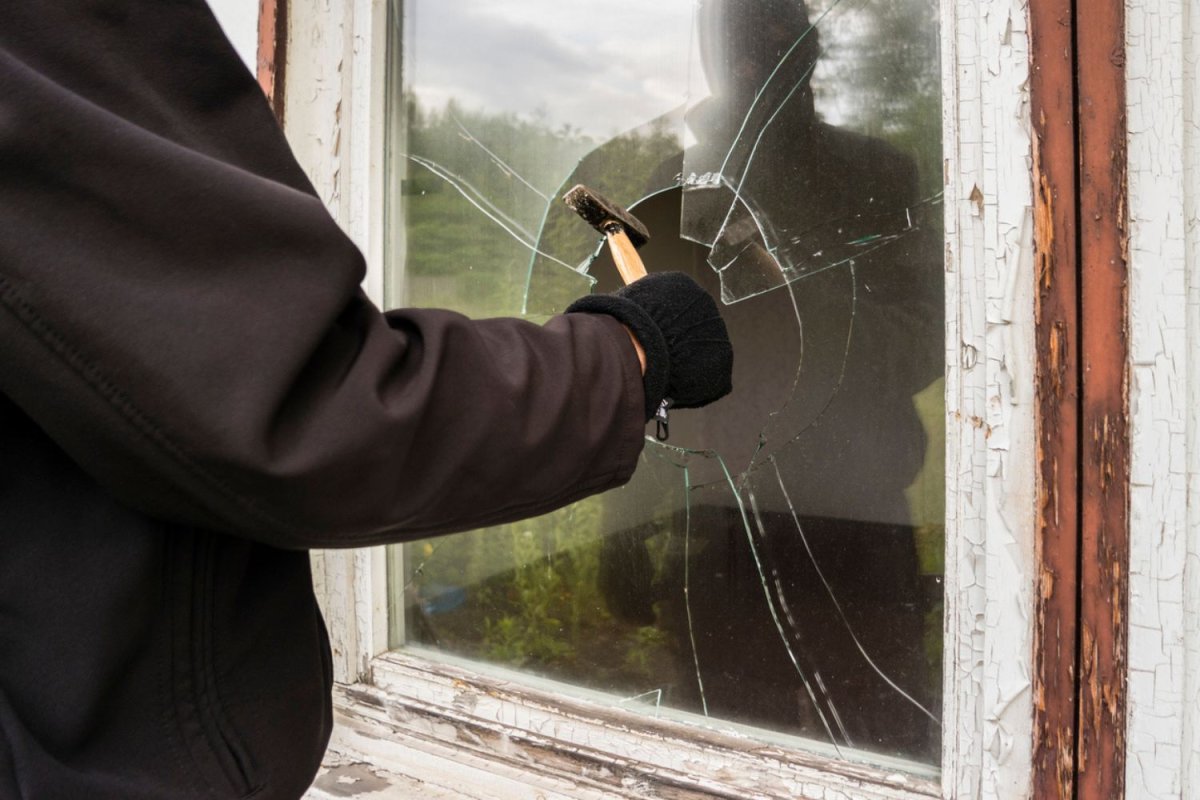We may earn revenue from the products available on this page and participate in affiliate programs. Learn More ›
Q: I’m looking to install a home security system, and the kit I’m looking at includes optional glass-break sensors. But how do glass-break sensors work, and are they different from motion sensors? What exactly do I need to know before installing them in my house?
A: Glass-break sensors aren’t as flashy as security cameras or video doorbells, but they’re a key part of many of the best home security systems (including Vivint and ADT). A glass-break sensor (sometimes called a glass-break detector) constantly monitors your home to detect breaking glass. Depending on your exact setup and sensor, this can then trigger an alarm or send an alert to your smartphone.
Not all glass-break sensors work the same way, and there are three types of sensors available on the market. Many of these play nicely with other security devices, making them a great complement to cameras, floodlights, motion detectors, and other common security gadgets.
“Choosing the type of glass break sensor depends on what you are specifically looking for in your home,” says Steve Grant, senior product manager at home security company Ring. Here’s a look at how glass-break sensors work, along with other factors you may want to consider before bundling them into your security system.
Glass-break sensors detect the sound or the movement of glass breaking.
At their most basic level, glass-break sensors are designed to monitor for breaking glass. There are a few different ways they go about this task, but the end goal is the same—alerting residents to glass that has been broken. These sensors are most commonly placed in rooms with windows that are easily accessible to intruders, allowing them to trigger should an intruder smash through the glass and attempt to bypass a lock. This makes glass-break sensors different from entry sensors, which are built to detect when doors or windows are opened or closed.
In addition to alerting residents to a break-in attempt, glass-break sensors can also notify residents if a skylight or window is broken by hail or high winds. That makes them an ideal all-around safety product, giving users peace of mind while away from home.
According to Tim Rader, senior director of product development at home security company ADT, “The placement of a glass break sensor varies based on factors such as the sensor type and manufacturer. While some sensors require mounting directly onto the glass, others are installed on walls or ceilings. Typically, most detectors should be positioned within 5 to 20 feet of windows or doors.”
There are three types of glass-break sensors: acoustic, shock, and dual sensors.
While all glass-break sensors are designed to detect glass breakage, not all products go about it the same way. Sensors typically fall into one of three categories—acoustic, shock, or dual.
- Acoustic glass-break sensors listen for the sound of breaking glass. If they detect anything that sounds like glass shattering, they will automatically trigger.
- Shock glass-break sensors detect the vibrations of breaking glass.
- Dual glass-breakage sensors are built with both acoustic and shock sensors, allowing them to employ techniques across both categories.
“Each type of glass-break sensor has its advantages and disadvantages, [so] when picking the right one for your home, multiple factors have to be considered such as location, weather, pets and more,” advises Rader. Shoppers will want to consider how they plan to use their glass-break sensors (and where they plan to install them) before opting for one over another. Regardless of which type a customer picks, the glass-break sensor battery will likely last for at least a year before needing to be replaced or recharged, making this type of sensor a great long-term investment.
Beyond glass-break sensors, there are several types of window alarm sensors that shoppers may want to consider. There are also car glass-break sensors, which come in a variety of styles but are designed specifically for use with a vehicle.

Acoustic sensors use built-in microphones to detect the sound of breaking glass.
Acoustic sensors can detect breaking glass using microphones, which means a single sensor properly placed in a room can monitor several windows or doors. However, these sensors can also be triggered falsely, potentially causing undue stress.
“An acoustic audio switch sensor detects the sound produced when glass breaks,” explains Rader. “However, it may also react to other similar frequencies, such as thunder, barking dogs, slamming doors or windows, or dishes breaking to name a few, potentially leading to false alarms.”
Despite this drawback, however, acoustic sensors are a popular choice. Instead of buying a glass-breaking sensor for each window or glass door, shoppers will find a single sensor to be adequate. Because of this, customers may find it worthwhile to invest in a premium model, as these sensors are better tuned to ignore secondary sounds and provide users with fewer accidental alerts.
Shock sensors detect the movement of breaking glass.
Shock sensors are radically different from acoustic sensors. Whereas acoustic sensors could be placed anywhere in a room, shock sensors are installed directly on a pane of glass. These devices are wired glass-break sensors that can detect vibrations on the surface through a small electrical wire. When this vibration becomes excessive, it indicates the glass has shattered.
“Shock sensors … respond to the vibrations caused by breaking glass but can also be activated by other sources like thunderstorms, fireworks, or sonic booms,” says Rader. Residents will also need to install one for each window or sliding glass door they’d like to monitor, which can be tedious and may get expensive for those with numerous windows or sliding glass doors in their home.
Aside from using glass-break sensors, there are several other ways for residents to secure a sliding glass door, and those who have serious concerns may want to think about adding more to their door than just a glass-break sensor. The same goes for French door security.
Dual sensors use both acoustic and shock sensors and require both the sound and movement of breaking glass to be triggered.
Dual sensors offer the benefits (and drawbacks) of both acoustic and shock sensors. These listen for audio cues as well as physical vibrations before triggering, resulting in fewer false alarms.
“Dual sensors combine both shock and audio detection capabilities, where both the vibration and sound of breaking glass can trigger an alarm,” explains Rader. “High frequency-low frequency glass break detectors, also referred to as flex-style detectors, are a type of dual-technology sensor. They distinguish themselves by sensing the low-frequency vibrations of glass as it flexes before breaking, followed by the higher-frequency sound of the glass breaking.”
This type of sensor needs to be installed directly on a pane of glass similar to shock sensors, but their built-in microphones help prevent activation from fireworks or thunderstorms. Dual sensors are usually more expensive than both shock and acoustic sensors, though their improved accuracy makes them a compelling purchase for homes with serious security concerns. Installing these throughout an entire home can become incredibly pricey, so shoppers may want to consider using them at key locations and opting for more affordable shock or acoustic sensors for the rest of their security system.
If the glass-break sensor is triggered, it will send a notification to the user and/or the professional monitoring company to alert the authorities.
Once a glass-break sensor is tripped, a few different events will happen depending on the exact model and how the sensor has been customized. Typically, the sensor will send an alert to the user via its companion mobile app, letting them know something has happened on their property. Sending an alert is a common feature of both professionally installed glass-break sensors and DIY security systems.
If the glass-break sensor is part of a security system that’s equipped with professional monitoring, a second alert will be sent to a dispatch service. From here, a technician can alert the authorities and send help to the home. Professional monitoring services aren’t cheap, but they often support much more than just glass-break sensors including cameras, motion sensors, and entry sensors. Customers will want to check the settings of their glass-break sensors to ensure they’re getting smart alerts that fit their needs, as most allow for a wide degree of customization.
It’s best to set up glass-break sensors in areas with a higher risk of intrusion.
Shoppers who don’t want to install window glass-break sensors on every window in their home will want to prioritize high-risk areas. Intruders are less likely to scale a wall and enter a second-floor window, making it better practice to protect first-floor windows. It’s also a good idea for customers to install one near a sliding glass door if their home is equipped with one. Homeowners whose homes have a basement may want to use glass-break sensors to improve their basement window security.
“Many glass break sensors offer adjustable sensitivity settings (from low, medium, or high), allowing users to personalize the sensors based on the room it’s in,” explains Rader. “For example, consumers may want to keep the sensitivity settings on low in the kitchen where glass may break regularly, but on high in a child’s room, where glass breaking in any scenario is an urgent matter.”
It’s also a good idea for customers to place a window glass-break detector on windows that aren’t covered by security cameras. This ensures there are no unprotected entryways into a home, and users will be alerted to actions missed by their camera. Conversely, placing glass-break detectors within sight of security cameras adds a second layer of protection to a home and is highly recommended for shoppers with serious security concerns. Users who are new to security systems will want to learn more about where to place security cameras before installing glass-break sensors—otherwise, they might need to uninstall and reinstall their equipment in a better location.
“You may want to install sensors on main floor windows or potentially basement egress windows where there is easy access, but you may choose to not install them on second or third floor windows,” explains Grant.
Once the high-risk areas of a home have been covered by glass-break sensors, only then will residents want to consider other areas.

If you have home security cameras set up, you can program glass-break sensors to trigger video recording.
Glass-break sensors are typically employed as part of a larger security system. While there’s nothing wrong with using only glass-break sensors to protect a home, they become infinitely more useful when paired with motion sensors, entry sensors, and security cameras.
Most glass-break sensors are designed to sync with other products—the most common pairing is with security cameras. Glass-break sensors can be programmed to trigger a nearby camera to start filming in the event they’re tripped. This allows users to capture footage of the event to show to authorities. Depending on the product, getting this cross-functionality programmed is as simple as loading a smartphone app. Shoppers interested in the feature will want to consult with their professional installation tech, or if performing a DIY install, the owner’s manual.
You can adjust the sensitivity of a glass-break sensor to avoid false alarms while still detecting true break-ins.
False alarms are one of the biggest complaints about glass-break sensors, as they cause undue stress and can be frustrating to deal with during a thunderstorm or if a dog starts barking. Fortunately, glass-break detector sensitivity is adjustable, allowing owners to tweak their performance and reduce false glass-break alarms.
For example, the Eva Logik Door Window Alarm, which is considered one of the best door and window alarms, lets users toggle its sensitivity with a built-in switch. This makes it easy to quickly change settings and find one that works for each household. It also allows users to turn sensitivity down during a thunderstorm or other triggering event, and then turn the sensitivity back to a higher setting when the event passes.
When used as part of a comprehensive home security system, glass-break sensors can enhance the safety and well-being of a home and its residents.
Glass-break sensors are useful on their own, but when paired with a comprehensive home security system, they serve as a great backup to cameras and motion sensors. Whether they’re used to activate nearby security devices, to cover windows outside the view of cameras, or as a second layer of protection for all of a home’s windows and sliding doors, glass-break sensors are an invaluable tool.
“Glass break sensors add an additional layer of security to your home, especially when used alongside other home security devices like window and door sensors, as well as motion sensors,” says Rader. “When paired with a more robust smart home, glass break sensors can trigger other automations like increasing light brightness or changing their colors, or activating recording on indoor and outdoor cameras.”
Shoppers will want to carefully consider whether acoustic, shock, or dual glass-break sensors are best for their household, as each comes with its own set of advantages and drawbacks. But regardless of which type is installed, it’ll play a vital role in keeping a home safe.
“Glass break sensors are useful on their own, but building a security solution that includes multiple types of sensors is a more comprehensive, powerful solution,” says Grant. “You can add door/window sensors, motion detectors and glass break sensors to your security system to better monitor all aspects of your home and be quickly informed if something goes wrong.”
Customers will also want to consider pairing their glass-break sensors with the best door and window alarms for a comprehensive system that offers impressive protection. Those who need help with this process can start by looking at the best home security systems, as these offer well-rounded packages that fit the needs of most properties.

